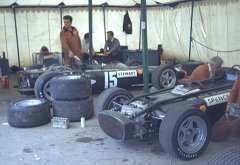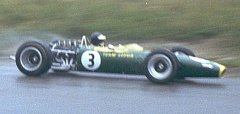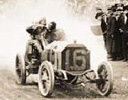The First Canadian Grand Prix
by Russell Jaslow
The Canadian Grand Prix is a strong fixture on the World
Championship circuit in Montreal, Quebec. The first race of this
event was a far cry from todayís style of races and the
cosmopolitan environs of the French Canadian city. That first
Canadian Grand Prix took place on one of the most famed yet
isolated tracks -- Mosport Park in Bowmanville, Ontario,
approximately 70 miles northeast of Toronto.
Mosport, whose name came from the concatenation of MOtor
SPORT, not from Stirling Moss who did help design the circuit,
was completed in 1961. The big event held there was a sports car
race which they called the Canadian Grand Prix. Winners of that
event were Peter Ryan, Masten Gregory, Pedro Rodriquez two years
in a row, Jim Hall, and Mark Donohue.
However, any racing fan knows that a true Grand Prix is one
that includes the Formula 1 cars and counts points towards the
World Drivers Title. Canada had worked for years to acquire such
an event, and in 1967, to help celebrate their Centennial, they
were finally awarded one. It took place on August 27 and would
prove to be quite an interesting race thanks to Mother Nature.
Practice, Qualifying and A Club Race Atmosphere
|
These were the days far removed from the ultra professional
and ultra safe modern times of Grand Prix racing. And, some would
say, a bit more fun. The cars were all housed under one large
tent placed in the infield, and it was not uncommon to see the
likes of Colin Chapman sitting on a toolbox due to the lack of
chairs.
|
 The corner of the tent set aside for the BRM team. See more photos in
our 1967 Canadian Grand Prix photo gallery. Photo courtesy
of
The corner of the tent set aside for the BRM team. See more photos in
our 1967 Canadian Grand Prix photo gallery. Photo courtesy
of |
In the first practice session, Jim Clark went off in Turn 1
and slowly backed it into the fence. He was forced to go to the
backup car which displaced local favorite, Canadian Eppie
Wietzes, who had to wait for the broken car to be fixed. This
prompted the local press to criticize Lotus for bringing too many
cars for only four mechanics to service.
Jim Clark won the pole with a time of 1:22.4, just barely
ahead of his teammate, Graham Hill, who was at 1:22.7. Dennis
Hulme qualified third at 1:23.2. Those three made up the front
row. Back in those days the field was configured in a 3-2-3-2
alternating order for the standing start.
Other doings in practice resembled a club race of today.
Mike Fisher was forced at one time to take apart the gearbox of
his Lotus-BRM to solve a leaking oil seal problem because all the
friends who volunteered to help him were not mechanically
inclined.
Jo Siffert, who qualified in the unlucky 13th spot, did not
start the race due to an age old problem -- he ran out of parts
after a crown wheel and pinion broke twice.
The "Three-Part" Race
As the race approached, the skies got darker and the 55,000
fans were wondering whether to pull out their umbrellas. When
the drivers got into their cars, the rain began to fall. On the
reconnaissance lap, Chris Amon, driving the lone Ferrari, spun
and caused all three of the BRM H16ís to pirouette in unison.
All recovered to make the start.
 Jim Clark battles the elements. See more photos in
our 1967 Canadian Grand Prix photo gallery. Photo courtesy
of
Jim Clark battles the elements. See more photos in
our 1967 Canadian Grand Prix photo gallery. Photo courtesy
of |
Clark, from the pole, had the advantage of seeing where he
was going and grabbed the early lead. However, this being the
first rain race of the 1967 season, he and his teammate quickly
learned how ill-suited their cars were to the wet. Having the
most horsepower, 400, in the field was a great asset for a dry
track, but a terrible hindrance in these conditions. Meanwhile,
the Repco-Brabham V8ís of Hulme and team owner Brabham were truly
suited for the rain.
|
Hulme immediately slotted in behind Clark and by the fourth
lap, the man leading the points title took the lead. Hulme
opened up a huge lead while the rain continued to fall. The Kiwi
thrilled the crowds at Turn 2 by consistently holding 300 yard
opposite lock slides all the way down this diving, treacherous
corner.
Bruce McLaren spun off on the third lap just after passing
Jack Brabham for fourth spot. McLaren dropped back to 12th, and
then began a masterful drive up the field. By lap 13, he was
back in third place.
Jochan Rindt pulled into the pits on lap 4 to have his
rollbar disconnected, but was unable to get the Maserati engine
to fire again.
Chris Amon repeated his warm-up lap spin on the opening race
lap. He resumed in last place. Amon would eventually work his
way back to sixth place and grab the last championship point.
Hulme worked his way to a 26 second advantage over McLaren,
who had since passed Clark for second, Jackie Stewart, Clark, who
continued to fall back in the order, and Brabham. The latter
four were separated by a mere second. Then, the rain stopped,
and the track dried out. The "Flying Scot" was back in his
element. The second part of the race would begin.
With the ability of applying the Lotus power to the ground,
the underpowered Brabham had no chance. Clark quickly passed
Stewart, then dispensed with McLaren on the next lap and began
his pursuit of the helpless Hulme.
On lap 58, Clark caught and passed Hulme for the lead. In
the process, he set the fastest lap of the race on lap 54 at
1:23.1 which tied the course record set by Dan Gurney in a Group
7 Can-Am car. Then, just as quickly, this part of the race was
over. The rain returned. This time with a vengeance.
With the rain falling heavier and heavier with each passing
lap, visibility was a major problem. David Hobbs stopped for a
clean set of goggles on lap 60. Stewart did the same four laps
later to clean off his car from an off course excursion. A lap
later he repeated his agricultural racing maneuver and finally
called it quits with a sticking throttle cable.
Clark was still able to hold onto his lead but not for long.
Running through a river of water, his electrics got soaked and
his engine stalled. He pulled off the course.
A Brabham passed him for the lead. It was not Hulme but
rather his boss, Jack. Jack Brabham was the only driver smart
enough to apply anti-fog to his goggles before the race. Hulme
was forced to pit twice. First, for a new set of goggles, then
for a visor to be put on his helmet.
Dan Gurney had the most interesting goggle adventure. Not
wanting to pit, he would slow on the main straight right in front
of the guardrail to have his mechanic toss him a new set. He
couldnít stop on the course for that would be considered
receiving aid on the track which was not legal.
The first time, the toss missed, and the goggles wrapped
themselves around the suspension. The second time, the
transaction was successful. It was a good thing, because before
that Gurney was forced to shield his eyes with his left hand
while driving with the other.
Meanwhile, Graham Hill spun and stalled the car. Hill
promptly jumped out of the car, push started the car himself, and
hopped back in to finish the race! Try that in a Grand Prix race
today.
Brabham went on to win while Hulme maintained second place.
American Dan Gurney grabbed the final podium spot, a lap down.
Hill brought his re-started Lotus back to fourth place, another
lap down, and Mike Spence finished fifth, three laps down.
 Jack Brabham was able to master the changing conditions better than anyone else which enabled
him to win the race. See more photos in our 1967 Canadian Grand
Prix photo gallery. Photo courtesy of
Jack Brabham was able to master the changing conditions better than anyone else which enabled
him to win the race. See more photos in our 1967 Canadian Grand
Prix photo gallery. Photo courtesy of |
Jack Brabham almost didnít make the race. Driving in from
Oshawa, he got caught up in the massive traffic jam heading to
the track. He was able to hitch a ride in an ambulance, perhaps
the last vehicle any racing driver would like to be in, and was
able to make the start thanks to the flashing lights and sirens.
Despite Brabhamís challenge with that victory, Hulme would
go on to win the 1967 World Drivers Title denying Brabham a
fourth championship.
The Subsequent Years
The first Grand Prix was a huge success, and Canada was
given a permanent spot on the calendar. The event alternated
between Mosport and Le Circuit Mont-Tremblant in St. Jovite,
Quebec for the first four years. Mosport became the permanent
site between 1971-1977 with the exception of 1975 when it was
cancelled due to a financial disagreement between the organizers
and entrants.
Despite being one of the most challenging tracks in the
world, Mosport did not keep up with the standards of the European
tracks, and the drivers began to voice their discontent.
The race was moved to a street circuit on the Ile Notre Dame
situated in the St. Lawrence seaway in Montreal. Built on the
site of Expo í67, it was constructed in just 3 months. It took a
few years and some modifications before the drivers were happy
with it, but it has now become an enjoyable facility for the
circuit.
It was renamed Gilles Villeneuve Circuit in 1982 after the
great and much beloved Canadian driver was killed earlier in the
season. He won this race in 1978. With the exception of 1987
when the race was cancelled due to a dispute over sponsorship and 2009 due to
a contract dispute between the promoters and Formula One Management, it
has been held here ever since.
Results of The 1967 Canadian Grand Prix
| 


